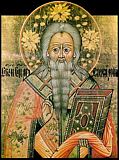

| Previous day | Next day |
| Old Style
February 10
|
Friday |
New Style
February 23
|
|
38th Week after Pentecost.
Tone 4.
Fast Day. |
Fish, wine and oil allowed.
|
![]() Hieromartyr Charalampus, bishop of Magnesia in Asia Minor, and Martyrs Porphyrius and Baptus (202).
Hieromartyr Charalampus, bishop of Magnesia in Asia Minor, and Martyrs Porphyrius and Baptus (202).
Martyrs Ennatha, Valentina, and Paula, of Palestine (308). St. Anna of Novgorod (1050). St. Prochorus of the Kiev Caves (1107). St. Longinus, founder of Koryazhemka Monastery (Vologda) (1540). St. Raphael, archimandrite (1765), and St. Ioannicius, hieromonk (1882), of Svatogorsk Monastery. Synaxis of Novgorod Hierarchs: Sts. Joachim (1030), Luke the Jew (1060), Germanus (1095), Arcadius (1162), Gregory (1193), Martyrius (1199), Anthony (1231), Basil (1352), Moses (1362), Symeon (1421), Gennadius (1504), Pimen (1571), and Athonius (1653).
“Areovindus” (“Fiery Vision”) Icon of the Most Holy Theotokos.
St. Scholastica of Italy (543), sister of St. Benedict of Nursia. St. Anastasius II, patriarch of Jerusalem (706). St. John Chimchimeli of Bachkovo and Gremi (13th c.).
Thoughts for Each Day of the Year
According to the Daily Church Readings from the Word of God
By St. Theophan the Recluse

Friday. [II Pet. 1:1–10; Mark 13:1–8]
Having enumerated the virtues which we must seek with all diligence, having received grace-filled power, the Apostle says by way of encouragement, If these things be in you, and abound, they make you that ye shall neither be barren nor unfruitful in the knowledge of our Lord Jesus Christ (II Pet. 1:8). The virtues to which he refers here were mentioned in I Pet. 2:21–3:9. Now we shall add only that we are required to manifest these virtues not just once, but rather to make them always abide in us, to be part of our essence, to take root in us. Thus, they must not remain on one level, but ever multiply and grow in strength and fruitfulness. Only then, he says, will you not be barren and unfruitful in the knowledge of our Lord Jesus Christ (II Pet. 1:8). He who believes in Him and confesses Him enters into the knowledge of the Lord. “You believe?” says the Apostle! See then, that your faith be not barren and unfruitful. What should I do, so that my faith will not be that way? Prosper in every virtue. Where are those who repeat over and over that believing is enough: that nothing more is needed?! Whoever thinks this way is blind.
Articles
 Hieromartyr Charalampus (Haralambos) the Bishop of Magnesia in ThessalyDespite the bishop’s advanced age (he was 113 years old), he was subjected to monstrous tortures. |
 Martyr Porphyrius in ThessalySaint Porphyrius was a soldier who suffered martyrdom with Saints Charalampus, Bishop of Magnesia, |
 Martyr Baptus in ThessalySaint Baptus was a soldier who suffered martyrdom with Saints Charalampus, Bishop of Magnesia, Porphyrius, and three women in the year 202. |
 Martyrs Ennatha, Valentina, and Paula, of PalestineThe Holy Virgin Martyrs Ennatha, Valentina and Paula suffered in the year 308 under the emperor Maximian II Galerius (305-311). |
 Orthodoxy in ScandinaviaMatthew HartleyGreat courage and perseverance were called for in the evangelization of those lands, and God raised up saints more than equal to the challenge. |
 Icon of the Mother of God “Areovindus”The origins of this unusual icon, in which the Most Holy Theotokos is depicted without Christ, are unknown. |








